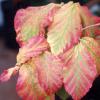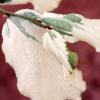 |
Stunning autumn colour - one of the best, even on chalk. The wood of Parrotia is so hard that it acquired the common name of "Ironwood". It forms a small tree of eventually wide habit, showing distinct layers when young. The flowers consist of clusters of crimson stamens in late winter, which look absolutely beautiful with the low winter sun on them. However, it is the fabulous autumn colour for which it is renowned. We grow a number of named forms which have been selected in different places at different times either for specific growth habits, or for even more spectacular colour than normal. Although related to Hamamelis, they do not need acid soil. They do surprisingly well on our heavy clay. If your soil is chalky, incorporate lots of organic matter to prevent them drying out in summer. |
| PARROTIA
persica Stunning autumn colour - one of the best, even on chalk. The wood of Parrotia is so hard that back in Medieval times it acquired the common name of "Ironwood". It forms a large shrub or small tree of very wide habit, showing distinct layers when young. The flowers consist of clusters of crimson stamens in late winter. However, it is the autumn colour for which it is renowned. |
|
|
|
|
|
NEW |
PARROTIA persica 'Belle' |
|
|
|
|
PARROTIA persica 'Biltmore' A wonderful clone derived from a plant in the Biltmore Gardens which is over 100 years old. It has a rounded habit and is low branching. The purple autumn colour is exceptional and the exfoliating winter bark enhances its winter interest. |
|
|
|
|
|
PARROTIA
persica 'Burgundy' |
|
|
|
|
| PARROTIA
persica 'Felicie' A selected form of this wonderful tree for autumn colour. |
|
|
|
|
|
|
PARROTIA
persica 'Lamplighter' Previously listed simply as Parrotia persica 'Variegata', I am pleased to correctly name it, since it is something special, not surprisingly courtesy of the late Stephen Taffler! The leaves are broadly and irregularly margined cream, pale green and dark green in the centre. The variegation can diminish when the plant is growing very strongly, but this is rarely a problem in the garden. The autumn colour is flushed with purple, continuing the variegation. A real Wow plant but I do warn you that it is difficult to establish. It has a lack of vigour due to its low amount of chlorophyll (because it is highly variegated). As it gradually gets bigger, so its ability to grow increases. It does therefore need careful planting to get it going. A shady site is vital, but avoid over watering. |
|
|
|
|
PARROTIA
persica 'Jodrell Bank' |
|
|
|
|
|
PARROTIA
persica 'Pendula' |
|
|
|
|
| PARROTIA
persica 'Vanessa' This form was selected for its more upright habit, but still with the same gorgeous autumn colours. |
|
|
|
|
|
NEW |
PARROTIA subaequalis |
|
|
|
| NEW | PARROTIOPSIS
jacquemontiana Although related to Hamamelis and Parrotia, the flowers of this handsome large shrub are more akin to those of Cornus florida, being actually large white bracts around a cluster of small yellow flowers. They are produced mainly in April-May but sporadically later in the summer. Good yellow autumn colours. |
